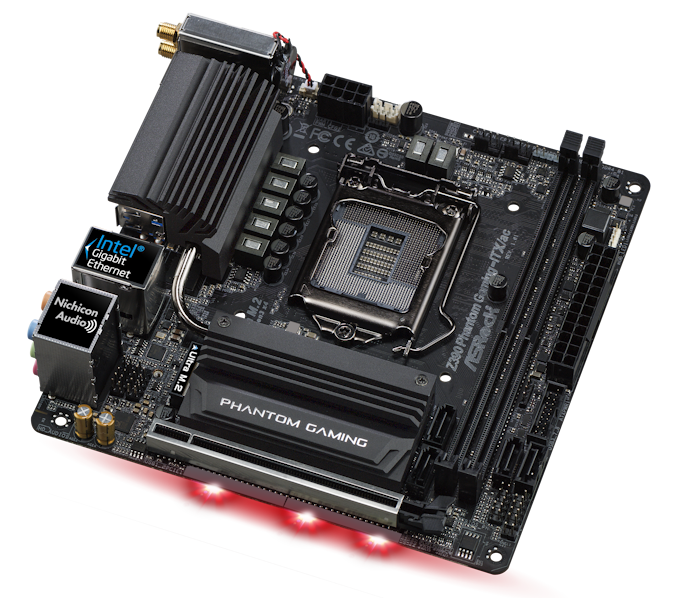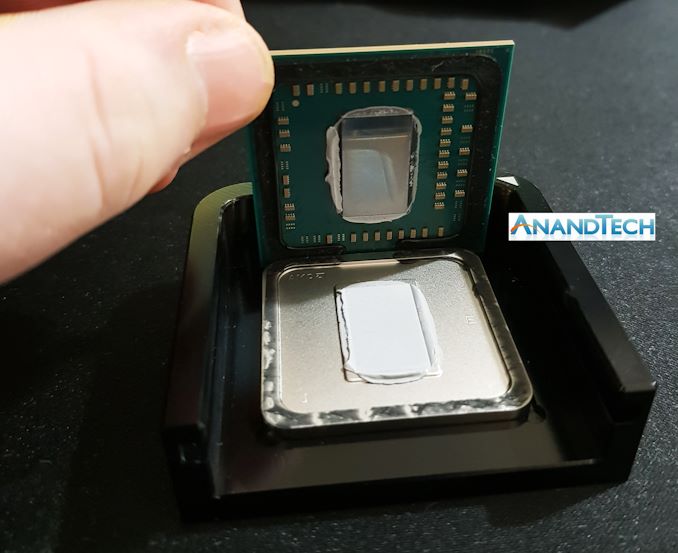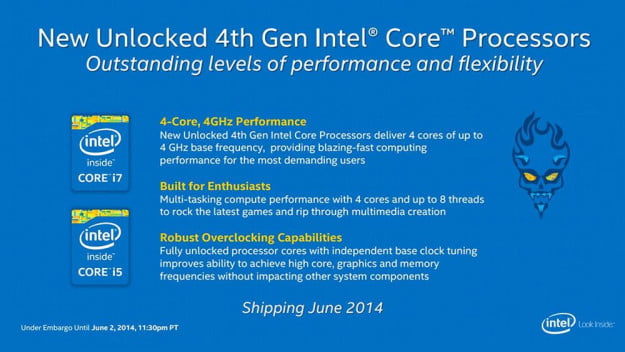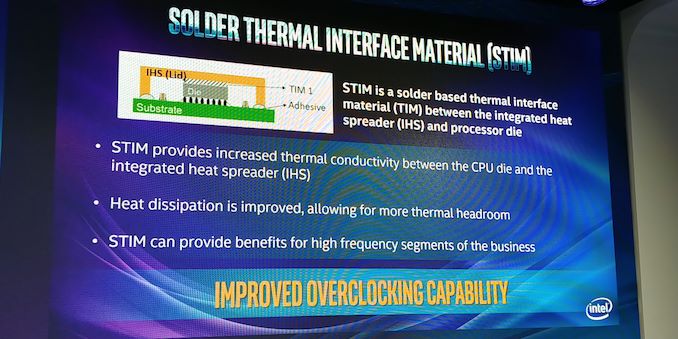The Intel 9th Gen Review: Core i9-9900K, Core i7-9700K and Core i5-9600K Tested
by Ian Cutress on October 19, 2018 9:00 AM EST- Posted in
- CPUs
- Intel
- Coffee Lake
- 14++
- Core 9th Gen
- Core-S
- i9-9900K
- i7-9700K
- i5-9600K
Hardware and Software Security Fixes
The Spectre and Meltdown vulnerabilities made quite a splash earlier this year, forcing makers of hardware and software to release updates in order to tackle them. There are several ways to fix the issues, including software, firmware, and hardware updates. Each generation of product is slowly implementing fixes, including some of the new 9th Generation processors.
At this point Intel has split the list down into 5/6 wide variants of different types of vulnerabilities. For all processors beyond mid-2018, here is what the fix table looks like:
| Spectre and Meltdown on Intel | |||||||
| AnandTech | SKX-R 3175X |
CFL-R | Cascade Lake | Whiskey Lake |
Amber Lake |
||
| Spectre | Variant 1 | Bounds Check Bypass | OS/VMM | OS/VMM | OS/VMM | OS/VMM | OS/VMM |
| Spectre | Variant 2 | Branch Target Injection | Firmware + OS | Firmware + OS | Hardware + OS | Firmware + OS | Firmware + OS |
| Meltdown | Variant 3 | Rogue Data Cache Load | Firmware | Hardware | Hardware | Hardware | Firmware |
| Meltdown | Variant 3a | Rogue System Register Read | Firmware | Firmware | Firmware | Firmware | Firmware |
| Variant 4 | Speculative Store Bypass | Firmware + OS | Firmware + OS | Firmware + OS | Firmware + OS | Firmware + OS | |
| Variant 5 | L1 Terminal Fault | Firmware | Hardware | Hardware | Hardware | Firmware | |
The new 9th Generation processors, listed as CFL-R (Coffee Lake Refresh), has implemented hardware fixes for variant 3, Rogue Data Cache Load, and variant 5, L1 Terminal Fault.
Because the new chips have required new masks for manufacturing, Intel has been able to make these changes. The goal of moving the changes into hardware means that the hardware is always protected, regardless of OS or environment, and with the hope that any additional overhead created by a software fix can be lessened if done in hardware.
(S)TIM: Soldered Down Processors
With the desktop processors we use today, they are built from a silicon die (the smart bit), a package substrate (the green bit), a heatspreader (the silver bit), and a material that helps transfer heat from the silicon die to the heatspreader. The quality of the binding between the silicon die and the heatspreader using this thermal interface material is a key component in the processors ability to remove the heat generated from using it.
Traditionally there are two different types of thermal material: a heat conductive paste, or a bonded metal. Both have positives and negatives.
The heat conductive paste is a universal tool – it can be applied to practically any manufactured processor, and is able to deal with a wide range of changing conditions. Because metals expand under temperature, when a processor is used and gets hot, it expands – so does the heatspreader. The paste can easily deal with this. This allows paste-based processors to live longer and in more environments. Using a bonded metal typically reduces the level of thermal cycling possible, as the metal also expands and contracts in a non-fluid way. This might mean the processors has a rated lifespan of several years, rather than a dozen years. However, the bonded metal solution performs a lot, lot better – metal conducts heat better than the silicon-based pastes – but it is slightly more expensive (a dollar or two per unit, at most, when the materials and manufacturing are taken into account).
| Thermal Interface | |||||||
| Intel | Celeron | Pentium | Core i3 | Core i5 | Core i7 Core i9 |
HEDT | |
| Sandy Bridge | LGA1155 | Paste | Paste | Paste | Bonded | Bonded | Bonded |
| Ivy Bridge | LGA1155 | Paste | Paste | Paste | Paste | Paste | Bonded |
| Haswell / DK | LGA1150 | Paste | Paste | Paste | Paste | Paste | Bonded |
| Broadwell | LGA1150 | Paste | Paste | Paste | Paste | Paste | Bonded |
| Skylake | LGA1151 | Paste | Paste | Paste | Paste | Paste | Paste |
| Kaby Lake | LGA1151 | Paste | Paste | Paste | Paste | Paste | - |
| Coffee Lake | 1151 v2 | Paste | Paste | Paste | Paste | Paste | - |
| CFL-R | 1151 v2 | ? | ? | ? | K = Bonded | - | |
| AMD | |||||||
| Zambezi | AM3+ | Bonded | Carrizo | AM4 | Bonded | ||
| Vishera | AM3+ | Bonded | Bristol R | AM4 | Bonded | ||
| Llano | FM1 | Paste | Summit R | AM4 | Bonded | ||
| Trinity | FM2 | Paste | Raven R | AM4 | Paste | ||
| Richland | FM2 | Paste | Pinnacle | AM4 | Bonded | ||
| Kaveri | FM2+ | Paste / Bonded* | TR | TR4 | Bonded | ||
| Carrizo | FM2+ | Paste | TR2 | TR4 | Bonded | ||
| Kabini | AM1 | Paste | |||||
| *Some Kaveri Refresh were bonded | |||||||
In our Ryzen APU delidding article, we went through the process of removing the heatspreader and conductive paste from a popular low cost product, and we showed that replacing that paste with a bonded liquid metal improved temperatures, overclocking, and performance in mid-range overclocks. If any company wants to make enthusiasts happy, using a bonded metal is the way to go.
For several years, Intel has always stated that they are there for enthusiasts. In the distant past, as the table above shows, Intel provided processors with a soldered bonded metal interface and was happy to do so. In recent times however, the whole product line was pushed into the heat conductive paste for a number of reasons.
As Intel was continually saying that they still cared about enthusiasts, a number of users were concerned that Intel was getting itself confused. Some believed that Intel had ‘enthusiasts’ and ‘overclockers’ in two distinct non-overlapping categories. It is what it is, but now Intel has returned to using applying STIM and wants to court overclockers again.
Intel has officially confirmed that new 9th generation processors will feature a layer of solder making up the TIM between the die and the IHS. The new processors with solder include the Core i9-9900K, the Core i7-9700K and Core i5-9600K.
As we’ll show in this review, the combination of STIM plus other features are of great assistance when pushing the new processors to the overclocking limits. Intel’s own overclocking team at the launch event hit 6.9 GHz temporarily using exotic sub-zero coolants such as liquid nitrogen.
Motherboards and the Z390 Chipset
One of the worst kept secrets this year has been Intel’s Z390 chipset. If you believe everything the motherboard manufacturers have told me, most of them had been ready for this release for several months, hence why seeing around 55 new motherboards hit the market this month and into next.
The Z390 chipset is an update to Z370, and both types of motherboards will support 8000-series and 9000-series processors (Z370 will need a BIOS update). The updates are similar to the updates seen with B360: native USB 3.1 10 Gbps ports, and integrated Wi-Fi on the chipset.
| Intel Z390, Z370 and Z270 Chipset Comparison | |||
| Feature | Z390 | Z370 | Z270 |
| Max PCH PCIe 3.0 Lanes | 24 | 24 | 24 |
| Max USB 3.1 (Gen2/Gen1) | 6/10 | 0/10 | 0/10 |
| Total USB | 14 | 14 | 14 |
| Max SATA Ports | 6 | 6 | 6 |
| PCIe Config | x16 x8/x8 x8/x4/x4 |
x16 x8/x8 x8/x4/x4 |
x16 x8/x8 x8/x4/x4 |
| Memory Channels | 2 | 2 | 2 |
| Intel Optane Memory Support | Y | Y | Y |
| Intel Rapid Storage Technology (RST) | Y | Y | Y |
| Max Rapid Storage Technology Ports | 3 | 3 | 3 |
| Integrated 802.11ac WiFi MAC | Y | N | N |
| Intel Smart Sound | Y | Y | Y |
| Integrated SDXC (SDA 3.0) Support | Y | N | N |
| DMI | 3.0 | 3.0 | 3.0 |
| Overclocking Support | Y | Y | Y |
| Intel vPro | N | N | N |
| Max HSIO Lanes | 30 | 30 | 30 |
| Intel Smart Sound | Y | Y | Y |
| ME Firmware | 12 | 11 | 11 |
The integrated Wi-Fi uses CNVi, which allows the motherboard manufacturer to use one of Intel’s three companion RF modules as a PHY, rather than using a potentially more expensive MAC+PHY combo from a different vendor (such as Broadcom). I have been told that the cost of implementing a CRF adds about $15 to the retail price of the board, so we are likely to see some vendors experiment with mid-price models with-and-without Wi-Fi using this method.

ASRock Z390 Phantom Gaming-ITX/ac
For the USB 3.1 Gen 2 ports, Type-A ports are supported natively and motherboard manufacturers will have to use re-driver chips to support Type-C reversibility. These come at extra cost, as one might expect. It will be interesting to see how manufacturers mix and match the Gen 2, Gen 1, and USB 2.0 ports on the rear panels, now they have a choice. I suspect it will come down to signal integrity on the traces on the motherboard.
For the Z390 chipset and motherboards, we have our usual every-board-overview post, covering every model the manufacturers would tell us about. Interestingly there is going to be a mini-ITX with Thunderbolt 3, and one board with a PLX chip! There are also some motherboards with Realtek’s 2.5G Ethernet controller – now if only we also had consumer grade switches.















274 Comments
View All Comments
Total Meltdowner - Sunday, October 21, 2018 - link
Those typoes.."Good, F U foreigners who want our superior tech."
muziqaz - Monday, October 22, 2018 - link
Same to you, who still thinks that Intel CPUs are made purely in USA :DHifihedgehog - Friday, October 19, 2018 - link
What do I think? That it is a deliberate act of desperation. It looks like it may draw more power than a 32-Core ThreadRipper per your own charts.https://i.redd.it/iq1mz5bfi5t11.jpg
AutomaticTaco - Saturday, October 20, 2018 - link
Revisedhttps://www.anandtech.com/show/13400/intel-9th-gen...
The motherboard in question was using an insane 1.47v
https://twitter.com/IanCutress/status/105342741705...
https://twitter.com/IanCutress/status/105339755111...
edzieba - Friday, October 19, 2018 - link
For the last decade, you've had the choice between "I want really fast cores!" and "I want lots of cores!". This is the 'now you can have both' CPU, and it's surprisingly not in the HEDT realm.evernessince - Saturday, October 20, 2018 - link
It's priced like HEDT though. It's priced well into HEDT. FYI, you could have had both of those when the 1800X dropped.mapesdhs - Sunday, October 21, 2018 - link
I noticed initially in the UK the pricing of the 9900K was very close to the 7820X, but now pricing for the latter has often been replaced on retail sites with CALL. Coincidence? It's almost as if Intel is trying to hide that even Intel has better options at this price level.iwod - Friday, October 19, 2018 - link
Nothing unexpected really. 5Ghz with "better" node that is tuned for higher Frequency. The TDP was the real surprise though, I knew the TDP were fake, but 95 > 220W? I am pretty sure in some countries ( um... EU ) people can start suing Intel for misleading customers.For the AVX test, did the program really use AMD's AVX unit? or was it not optimised for AMD 's AVX, given AMD has a slightly different ( I say saner ) implementation. And if they did, the difference shouldn't be that big.
I continue to believe there is a huge market for iGPU, and I think AMD has the biggest chance to capture it, just looking at those totally playable 1080P frame-rate, if they could double the iGPU die size budget with 7nm Ryzen it would be all good.
Now we are just waiting for Zen 2.
GreenReaper - Friday, October 19, 2018 - link
It's using it. You can see points increased in both cases. But AMD implemented AVX on the cheap. It takes twice the cycles to execute AVX operations involving 256-bit data, because (AFAIK) it's implemented using 128-bit registers, with pairs of units that can only do multiplies or adds, not both.That may be the smart choice; it probably saves significant space and power. It might also work faster with SSE[2/3/4] code, still heavily used (in part because Intel has disabled AVX support on its lower-end chips). But some workloads just won't perform as well vs. Intel's flexible, wider units. The same is true for AVX-512, where the workstation chips run away with it.
It's like the difference between using a short bus, a full-sized school bus, and a double decker - or a train. If you can actually fill the train on a regular basis, are going to go a long way on it, and are willing to pay for the track, it works best. Oh, and if developers are optimizing AVX code for *any* CPU, it's almost certainly Intel, at least first. This might change in the future, but don't count on it.
emn13 - Saturday, October 20, 2018 - link
Those AVX numbers look like they're measuing something else; not just AVX512. You'd expect performance to increase (compared to AVX256) by around 50%, give or take quite a margin of error. It should *never* be more than a factor 2 faster. So ignore AMD; their AVX implementation is wonky, sure - but those intel numbers almost have to be wrong. I think the baseline isn't vectorized at all, or something like that - that would explain the huge jump.Of course, AVX512 is fairly complicated, and it's more than just wider - but these results seem extraordinary; and there' just not enough evidence the effect is real, not just some quirk of how the variations were compiled.